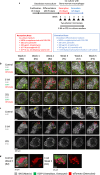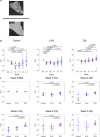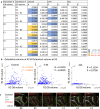Inhibition of cysteine protease disturbs the topological relationship between bone resorption and formation in vitro
- PMID: 38376670
- PMCID: PMC10982105
- DOI: 10.1007/s00774-023-01489-w
Inhibition of cysteine protease disturbs the topological relationship between bone resorption and formation in vitro
Abstract
Introduction: Osteoporosis is a global health issue. Bisphosphonates that are commonly used to treat osteoporosis suppress both bone resorption and subsequent bone formation. Inhibition of cathepsin K, a cysteine proteinase secreted by osteoclasts, was reported to suppress bone resorption while preserving or increasing bone formation. Analyses of the different effects of antiresorptive reagents such as bisphosphonates and cysteine proteinase inhibitors will contribute to the understanding of the mechanisms underlying bone remodeling.
Materials and methods: Our team has developed an in vitro system in which bone remodeling can be temporally observed at the cellular level by 2-photon microscopy. We used this system in the present study to examine the effects of the cysteine proteinase inhibitor E-64 and those of zoledronic acid on bone remodeling.
Results: In the control group, the amount of the reduction and the increase in the matrix were correlated in each region of interest, indicating the topological and quantitative coordination of bone resorption and formation. Parameters for osteoblasts, osteoclasts, and matrix resorption/formation were also correlated. E-64 disrupted the correlation between resorption and formation by potentially inhibiting the emergence of spherical osteoblasts, which are speculated to be reversal cells in the resorption sites.
Conclusion: These new findings help clarify coupling mechanisms and will contribute to the development of new drugs for osteoporosis.
Keywords: Bone remodeling; Cathepsin K; Coupling; Osteoblast; Osteoclast; Two-photon microscopy.
© 2024. The Author(s).
Conflict of interest statement
A. Hikita held an endowed chair supported by Fujisoft Inc. until 31 October 2020 and an endowed chair supported by CPC Corporation, Kyowa Co., Ltd., Kanto Chemical Co., Inc., and Nichirei Corp. from 1 July 2021 to 30 June 2022 and has been affiliated with the social cooperation program of Kohjin Bio Co., Ltd. since 1 July 2022. N. Tsuji has been affiliated with the social cooperation program of Kohjin Bio Co., Ltd. since 1 April 2023. S. Ono, T. Sakamoto, S. Oguchi, T. Nakamura, and K. Hoshi declare no potential conflict of interest.
Figures











Similar articles
-
Azanitrile Cathepsin K Inhibitors: Effects on Cell Toxicity, Osteoblast-Induced Mineralization and Osteoclast-Mediated Bone Resorption.PLoS One. 2015 Jul 13;10(7):e0132513. doi: 10.1371/journal.pone.0132513. eCollection 2015. PLoS One. 2015. PMID: 26168340 Free PMC article.
-
[Reducing bone resorption by cathepsin K inhibitor and treatment of osteoporosis].Clin Calcium. 2014 Jan;24(1):59-67. Clin Calcium. 2014. PMID: 24369281 Review. Japanese.
-
Osteoclastic bone degradation and the role of different cysteine proteinases and matrix metalloproteinases: differences between calvaria and long bone.J Bone Miner Res. 2006 Sep;21(9):1399-408. doi: 10.1359/jbmr.060614. J Bone Miner Res. 2006. PMID: 16939398
-
Bisphosphonate-osteoclasts: changes in osteoclast morphology and function induced by antiresorptive nitrogen-containing bisphosphonate treatment in osteoporosis patients.Bone. 2014 Feb;59:37-43. doi: 10.1016/j.bone.2013.10.024. Epub 2013 Nov 6. Bone. 2014. PMID: 24211427
-
Inhibition of cathepsin K for treatment of osteoporosis.Curr Osteoporos Rep. 2012 Mar;10(1):73-9. doi: 10.1007/s11914-011-0085-9. Curr Osteoporos Rep. 2012. PMID: 22228398 Review.
Cited by
-
MIR155HG suppresses the osteogenic differentiation of bone marrow mesenchymal stem cells through regulating miR-155-5p and DKK1 expression.J Orthop Surg Res. 2025 Apr 19;20(1):392. doi: 10.1186/s13018-025-05798-w. J Orthop Surg Res. 2025. PMID: 40251598 Free PMC article.
References
-
- Klibanski A, Adams-Campbell L, Bassford T, et al. Osteoporosis prevention, diagnosis, and therapy. J Am Med Assoc. 2001;285:785–795. doi: 10.1001/jama.285.6.785. - DOI
MeSH terms
Substances
Grants and funding
LinkOut - more resources
Full Text Sources
Medical

